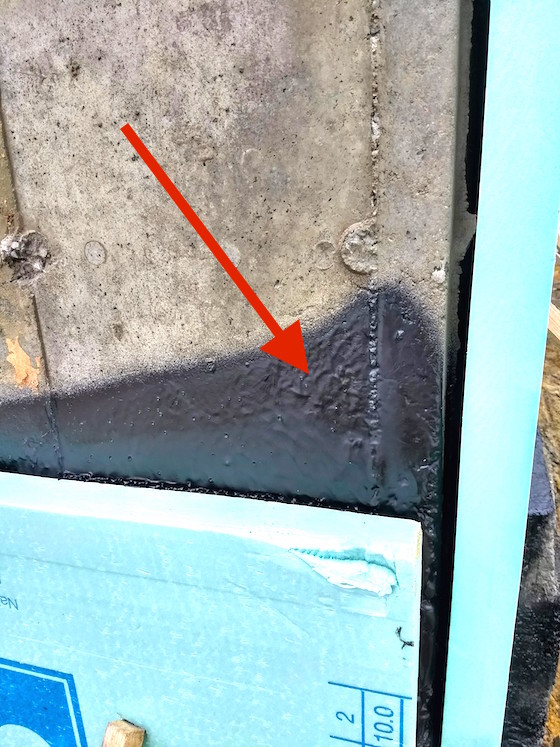Waterproof Foundation & Damp Proofing

The black goo is foundation waterproofing. The red arrow points to the thick coating where it's sagged. Damproofing is much thinner like a simple coat of paint. Copyright 2018 Tim Carter
Exterior Foundation Waterproofing Compounds
Foundation waterproofing is probably one of the most confusing aspects of residential construction. Thousands of homeowners think they have a waterproofed foundation, when in fact they do not.
Waterproofing is generally not used by a majority of builders, due to its higher cost. In an effort to stay competitive, some builders will cut corners in areas where the homeowner cannot easily see the finished product.
Waterproofing is a prime example of this, due to the fact that it is generally covered early in the job by the dirt around the foundation. However, the higher initial cost of waterproofing is well worth it. Interior waterproofing methods used after a leak has developed are generally not as effective as a compound applied to the exterior surface of the foundation.
Related Links
Drain Tile Installation - 98% of Builders Do it WRONG
Drain Tile and Foundation Backfilling Tips
Damproofing - Not The Same as Foundation Waterproofing
Foundation waterproofing is often confused with "damp proofing." Damp proofing is a process which retards or slows water penetration into foundations. Damp proofing is usually performed by applying unmodified asphalt coatings to the foundation surfaces.
Free & Fast Bids
CLICK HERE to get FREE & FAST BIDS from local foundation waterproofing companies.
Most of these products become brittle when dry. Some of them can actually be dissolved by groundwater. Virtually none of them have the ability to bridge foundation cracks.
However, damp proofing compounds are generally very effective in stopping water vapor transmission. Untreated concrete or other masonry products readily absorb water from the soil around your house. This water travels through the concrete and evaporates from the inside surface of the basement wall.
Water Vapor Passes Through Concrete
Frequently the walls will appear dry, however, the water is still being transmitted into your basement. Unless a water vapor barrier was installed beneath your floor, this same thing is happening with your basement concrete slab. That is why older houses frequently have "damp" feeling basements. The widespread use of damp proofing methods did not begin until the 1950's.
Waterproofing, on the other hand, is very different from damp proofing. Waterproofing compounds are designed to stop water infiltration.
These compounds or membranes can be extremely effective when applied to the exterior of a foundation system. There are a wide variety of waterproofing products available to homeowners.
Wide Variety of Waterproofing Methods & Products
They are vastly different in their composition. Some of these products are urethane based, others are modified asphalts, some are clay based and some are rubber polymers.
If you’re interested in learning more about foundation waterproofing cost I have an article here.
Most of these compounds have the ability to bridge cracks that might later develop in a foundation. This is extremely important. Some compounds can bridge much bigger cracks than others. When installed properly, these waterproofing compounds can keep a basement dry for many, many years.
CLICK HERE to get FREE & FAST BIDS from local foundation waterproofing companies.
Column B15